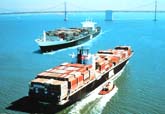After years spent boosting their fleets and adding new services, ocean container carriers are reducing the number of ships in service as cargo volumes shrink across their global liner networks.
The combined active fleet operated by the top 24 container shipping lines has declined by 4 percent over the past 12 months, according to Alphaliner, the Paris-based analyst.
The active fleet has fallen to 10.43 million TEUs from10.86 million TEUs last September before the container shipping market started its "precipitous" decline.
If ships idled by the top 24 carriers are included the operating fleet has risen to 11.1 million TEUs, Alphaliner notes.
Despite the reduction in the overall active fleet, seven carriers have increased their capacity, led by Geneva-based Mediterranean Shipping Co. and France's CMA CGM, the world's second and third largest operators, whose fleets grew by eleven percent and six percent respectively. United Arab Shipping Co.'s fleet has gained 16 percent over the past year.
However, the gains were "forced" on the carriers due to the delivery of new owned tonnage and chartered ships that were fixed before the start of the current crisis, Alphaliner points out.
"These carriers have little or no idle capacity and have managed to increase their market share in the process," the analyst says.
Maersk Line, the biggest carrier, has trimmed its fleet by 5 percent since September. China's CSCL is down 18 percent, Hong Kong-based OOCL 16 percent, Mitsui OSK Line of Japan 14 percent and Taiwanese carrier Evergreen 13 percent.
Malaysia's MISC has slashed its active fleet by 39 percent and Israeli carrier Zim has taken out 19 percent of its capacity.
The Journal of Commerce Online













